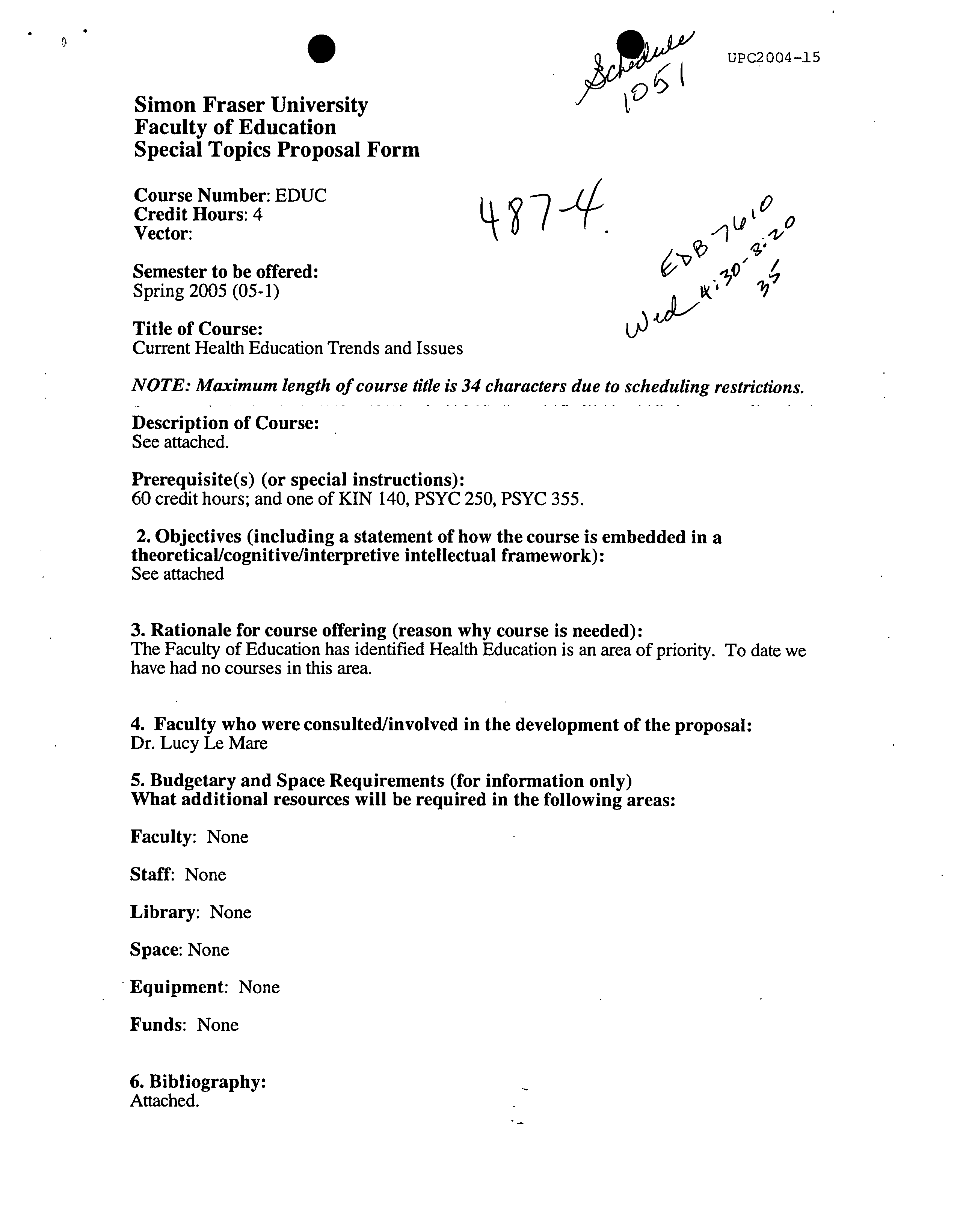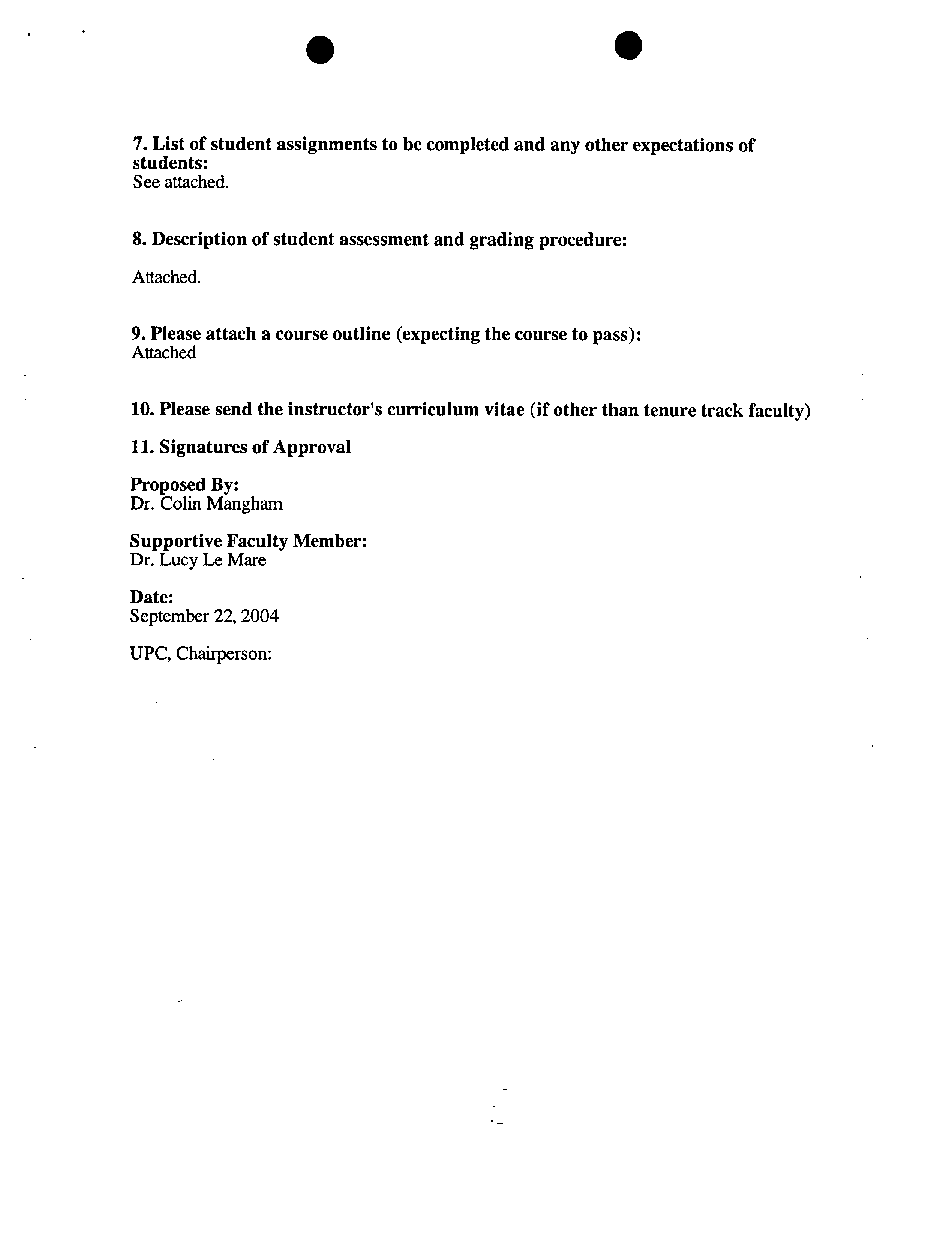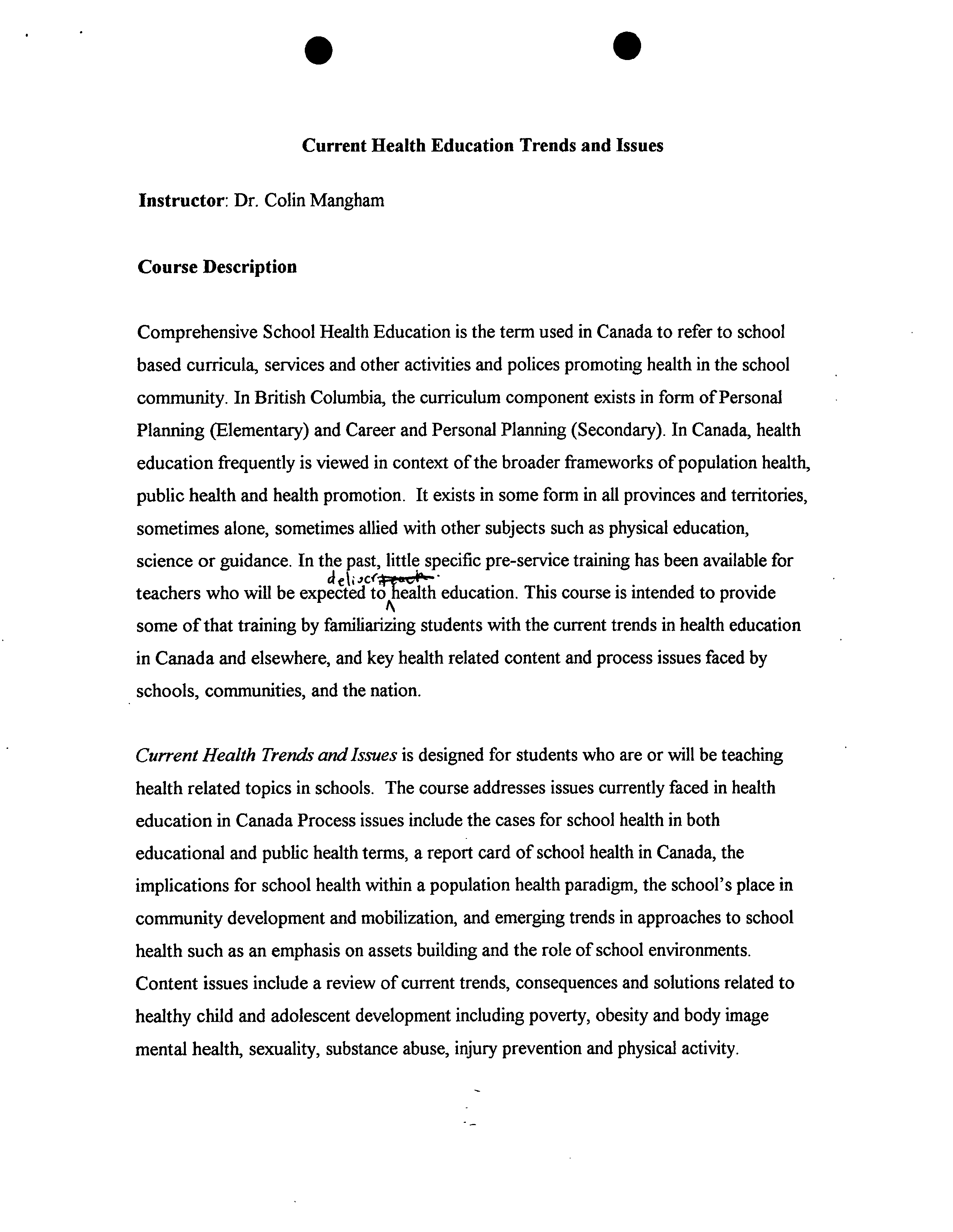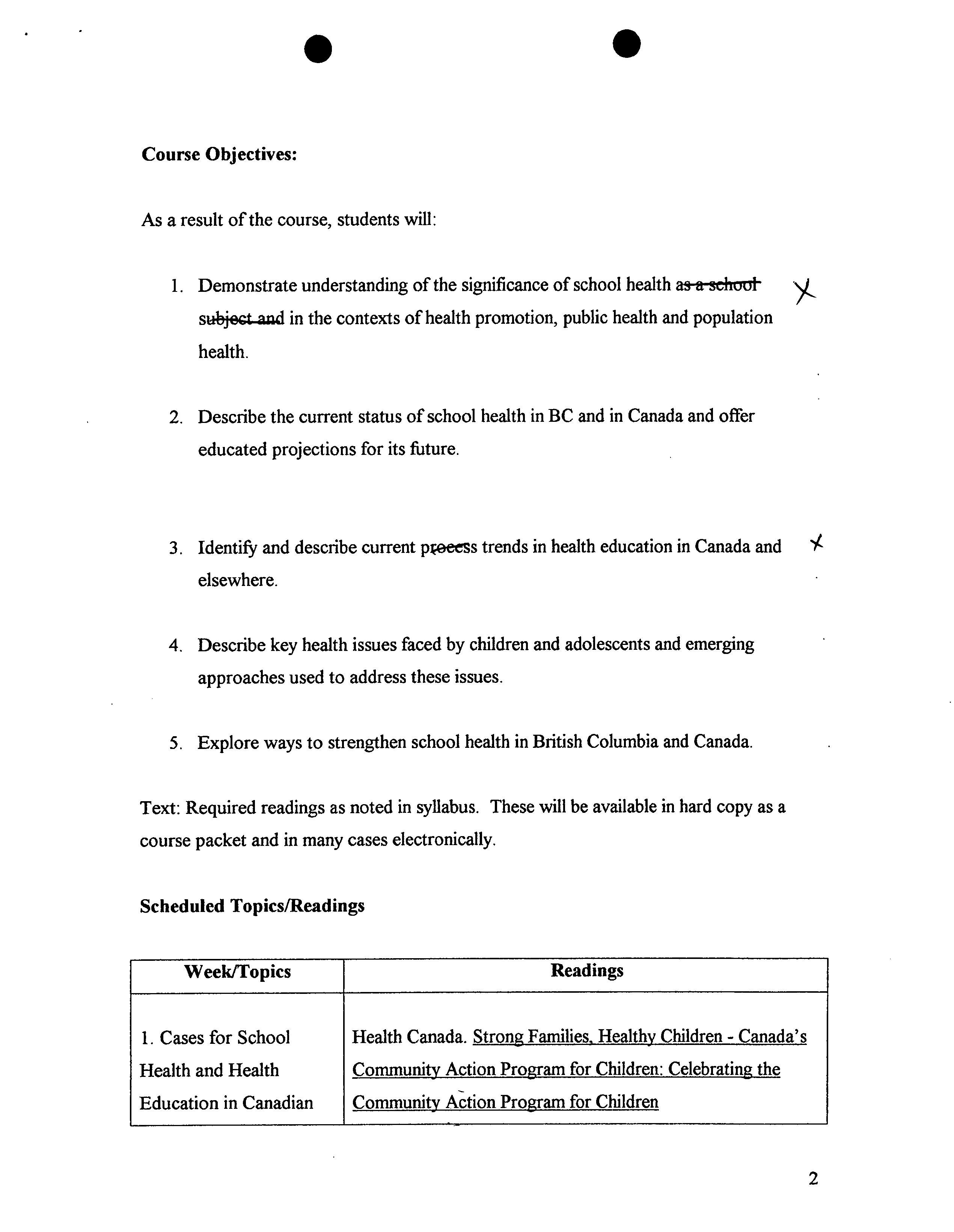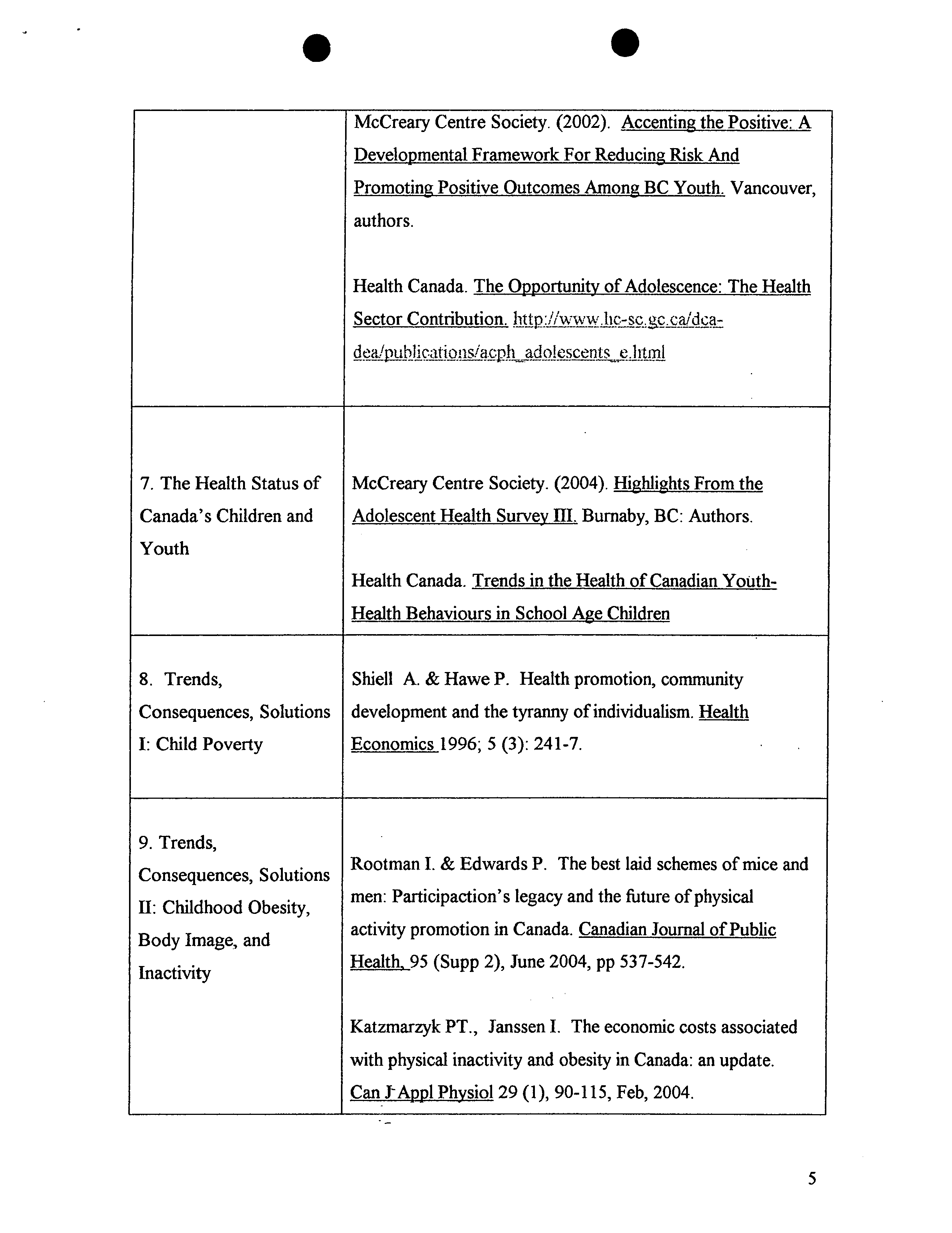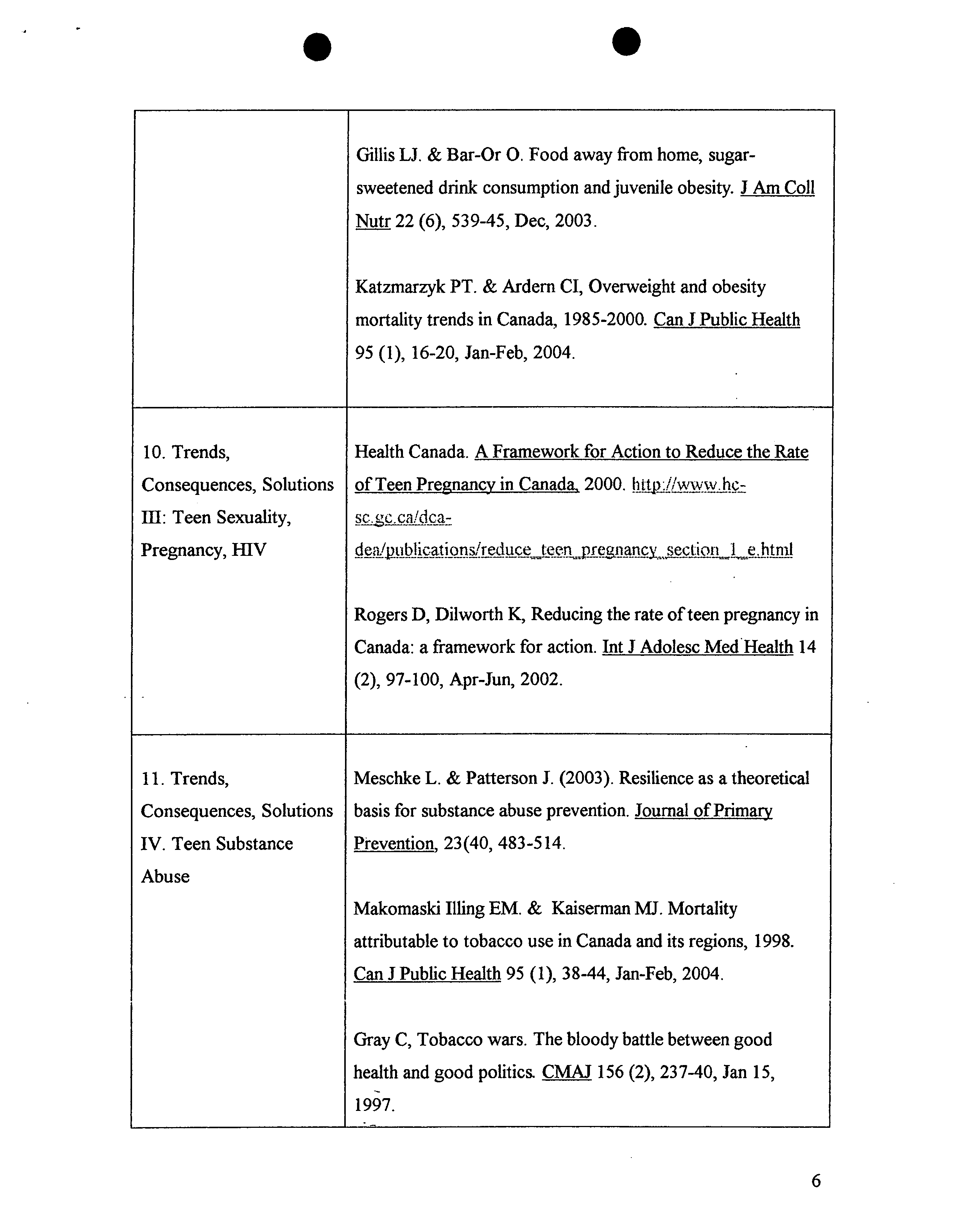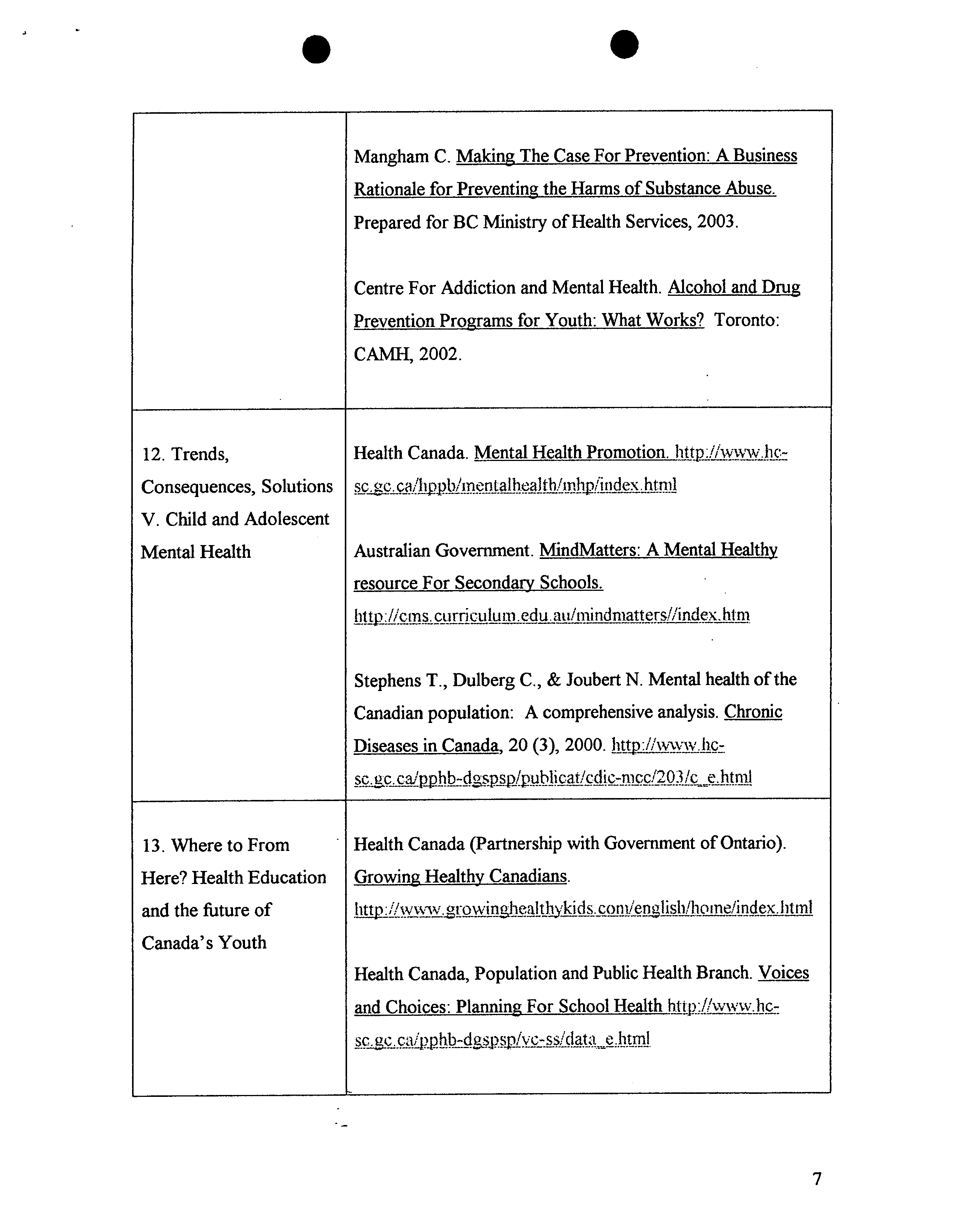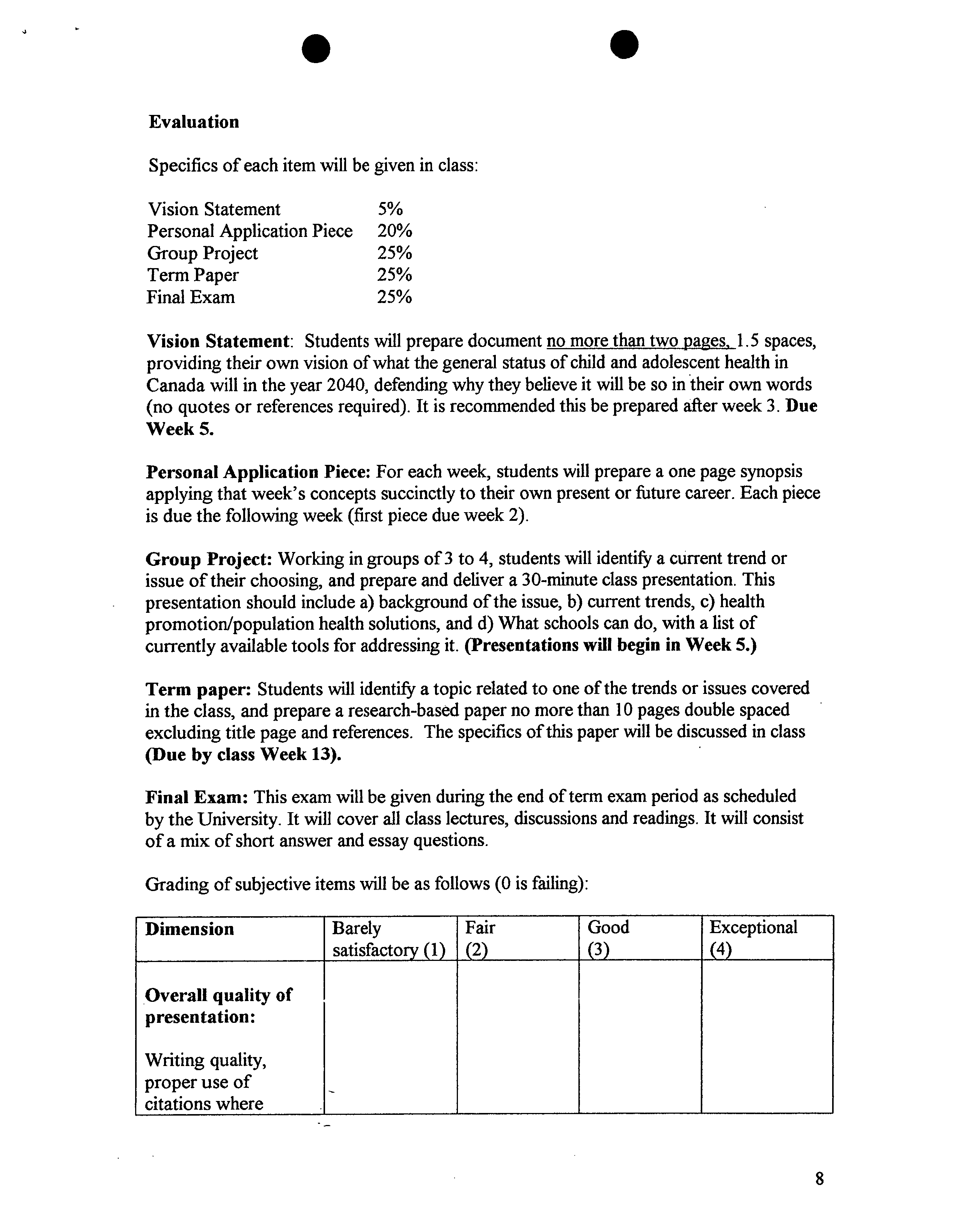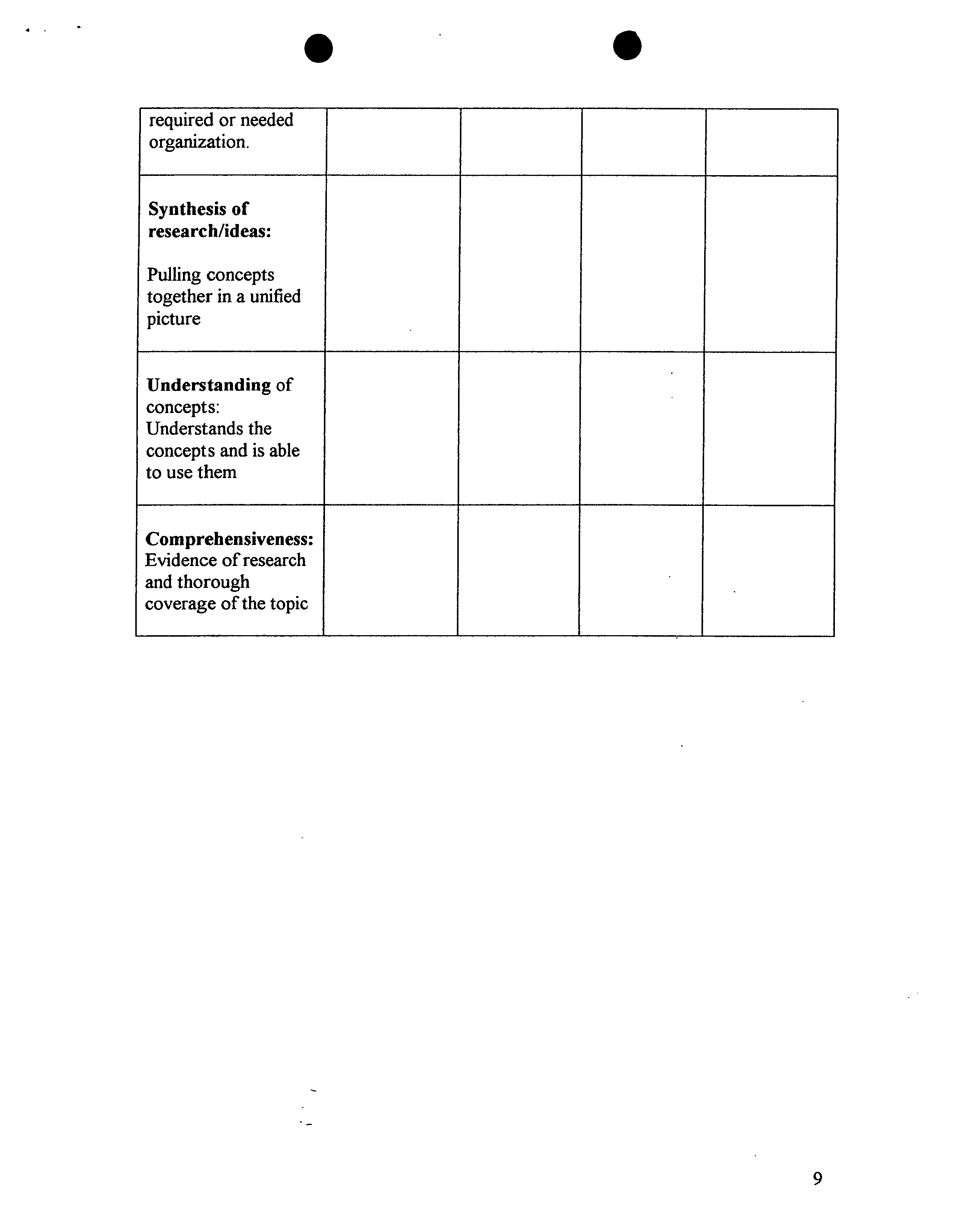^n4.
L0
.1j
?
o
V
17
E
?
0PC2004-.15
Simon Fraser University
Faculty of Education
Special Topics Proposal Form
Course Number: EDUC
Credit Hours: 4
Vector:
Semester to be offered:
Spring 2005 (05-1)
Title of Course:
Current Health Education Trends and Issues
NOTE: Maximum length of course title is 34 characters due to scheduling restrictions.
Description of Course:
See attached.
Prerequisite(s) (or special instructions):
60 credit hours; and one of KIN 140, PSYC 250, PSYC
355.
2. Objectives (including a statement of how the course is embedded in a
theoretical/cognitive/interpretive intellectual framework):
See attached
3. Rationale for course offering (reason why course is needed):
The Faculty of Education has identified Health Education is an area of priority. To date we
have had no courses in this area.
4. Faculty who were consulted/involved in the development of the proposal:
Dr. Lucy Le Mare
5.
Budgetary and Space Requirements (for information only)
What additional resources will be required in the following areas:
Faculty: None
Staff: None
Library: None
Space: None
Equipment: None
Funds: None
6. Bibliography:
Attached.
. ?
.
7.
List of student assignments to be completed and any other expectations of
students:
See attached.
8.
Description of student assessment and grading procedure:
Attached.
9.
Please attach a course outline (expecting the course to pass):
Attached
10.
Please send the instructor's curriculum vitae (if other than tenure track faculty)
11.
Signatures of Approval
Proposed By:
Dr. Colin Mangham
Supportive Faculty Member:
Dr. Lucy Le Mare
Date:
September 22, 2004
UPC, Chairperson:
Current Health Education Trends and Issues
Instructor:
Dr. Cohn Mangham
Course Description
Comprehensive School Health Education is the term used in Canada to refer to school
based curricula, services and other activities and polices promoting health in the school
community. In British Columbia, the curriculum component exists in form of Personal
Planning (Elementary) and Career and Personal Planning (Secondary). In Canada, health
education frequently is viewed in context of the broader frameworks of population health,
public health and health promotion. It exists in some form in all provinces and territories,
sometimes alone, sometimes allied with other subjects such as physical education,
science or guidance. In the past, little specific pre-service training has been available for
teachers who will be expected to
,
ealth education. This course is intended to provide
some of that training by familiarizing students with the current trends in health education
in Canada and elsewhere, and key health related content and process issues faced by
schools, communities, and the nation.
Current Health Trends and Issues
is designed for students who are or will be teaching
health related topics in schools. The course addresses issues currently faced in health
education in Canada Process issues include the cases for school health in both
educational and public health terms, a report card of school health in Canada, the
implications for school health within a population health paradigm, the school's place in
community development and mobilization, and emerging trends in approaches to school
health such as an emphasis on assets building and the role of school environments.
Content issues include a review of current trends, consequences and solutions related to
healthy child and adolescent development including poverty, obesity and body image
mental health, sexuality, substance abuse, injury prevention and physical activity.
. ?
.
Course Objectives:
As a result of the course, students will:
1.
Demonstrate understanding of the significance of school health as-a schcnil-
set..ad in the contexts of health promotion, public health and population
health.
2.
Describe the current status of school health in BC and in Canada and offer
educated projections for its future.
3.
Identify and describe current pceeess trends in health education in Canada and
elsewhere.
4.
Describe key health issues faced by children and adolescents and emerging
approaches used to address these issues.
5.
Explore ways to strengthen school health in British Columbia and Canada.
Text: Required readings as noted in syllabus. These will be available in hard copy as a
course packet and in many cases electronically.
Scheduled Topics/Readings
Week/Topics
Readings
1. Cases for School
Health and Health
Education in Canadian
Health Canada. Strong Families, Healthy Children - Canada's
CommuW!y Action Program for Children: Celebrating the
Communit y
Action Program for Children
2
C
?
.
Schools; Where Are We;
A Report Card
Mutter GW, Ashworth C, Cameron H. Canada: perspectives
in school health. J Sch Health 60: (7), 308-12, Sep, 1990.
Office of the Provincial Health Officer. An Ounce of
Prevention: The Public Health Case For Comprehensive
School Health. Victoria: Queen's Printer, 2004.
2. The Determinants of
Health Canada. The Population Health Approach.
Health and Child and
qL
Adolescent Health:
Health Education,
Labonte R. Population health and health promotion: What do
Health Promotion,
they have to say to each other? Canadian Journal of Public
Public Health,
Health 1995; 86(3):
165-68.
Population Health,
Concepts of Health and
Health Canada: Healthy Development of Children and Youth
Health Education;
Best
-
The Role of the Determinants of Health (Full Report)
Practice
and
Evidence -
Based
as Concepts
Hoffman K. & Jackson S. A Review Of The Evidence For
The Effectiveness And CostsOf Interventions Preventing The
Burden Of Noncommunicable Diseases: How Can Health
Systems Respond? Toronto: University of Toronto, 2003.
Kahan, B., & Goodstadt, M. 1DM Manual: 1DM Manual for
using the Interactive Domain Model approach to best
practices in health promotion. Toronto: Centre for Health
Promotion, University of Toronto, 2002.
3. The School
Canadian Asociation for School Health, (undated) Consensus
. ?
S
Community and the
Statement on Comprehensive School Health.
Community School:
htrn
Comprehensive School
Health, Healthy Schools;
Hancock T. The evolution,, impact and significance of the
Health Promoting
Healthy Cities! Healthy Communities movement. Journal of
Schools Movement
Public Health Policy 1993; 14(1): 5-18.
World Health Organization. What Is a Health Promoting
School?
4. Assets Building and
Resiliency: Current
Trends
Mangham, C. McGrath, P. Reid, G. & Stewart, M. (1995).
Resilience in Health Promotion. Ottawa: Minister of Supply
and Services Canada.
5.Fostering Healthy
Shaps, E. & Solomon, D. (2003). The role of the school's
School Environments:
social environment in preventing student drug use. Journal of
The Crucible of the
Primary Prevention, 23(3), 299-328
School
6. Child and Adolescent
McBride, N., Midford, R. & Cameron, I. (1999). An empirical
Development: Generic
model for school health promotion: The Western Australian
Models
school health project model. Health Education International,
14(1), 17-25.
. ?
S
McCreary Centre Society. (2002). Accenting the Positive: A
Developmental Framework For Reducing Risk And
Promoting Positive Outcomes Among BC Youth. Vancouver,
authors.
Health Canada. The Opportunity of Adolescence: The Health
Sector Contribution. httplIwww.hc-sc.gccaidca-
deblicationsIacjhcenselnl
7. The Health Status of
McCreary Centre Society. (2004). Highlights From the
Canada's Children and
Adolescent Health Surve
y
III.
Burnaby, BC: Authors.
Youth
Health Canada. Trends in the Health of Canadian Youth-
Health Behaviours in School Age Children
8. Trends,
Shieil A. & Hawe P. Health promotion, community
Consequences, Solutions
development and the tyranny of individualism. Health
I: Child Poverty
Economics 1996;
5 (3):
241-7.
9. Trends,
Consequences, Solutions
Rootman I. & Edwards P. The best laid schemes of mice and
II:
Childhood Obesity,
men: Participaction's legacy and the future of physical
Body Image, and
activity promotion in Canada. Canadian Journal of Public
Inactivity
Health, 95 (Supp 2), June 2004,
pp
537-542.
Katzmarzyk PT., Janssen I. The economic costs associated
with physical inactivity and obesity in Canada: an update.
Can JAppl Physiol 29(1), 90-115, Feb, 2004.
S
?
S
Gillis U. & Bar-Or 0. Food away from home, sugar-
sweetened drink consumption and juvenile obesity. J Am Coil
Nutr 22 (6),
539-45,
Dec, 2003.
Katzmarzyk PT. & Ardern CI, Overweight and obesity
mortality trends in Canada, 1985-2000. Can J Public Health
95 (1),
16-20, Jan-Feb, 2004.
10. Trends,
Health Canada. A Framework for Action to Reduce the Rate
Consequences, Solutions
of Teen Pregnancy in Canada, 2000.
htp://wwwhc-
Ill: Teen Sexuality,
Pregnancy, HIV
Rogers D, Dilworth K, Reducing the rate of teen pregnancy in
Canada: a framework for action. Tnt J Adolesc MedHealth 14
(2), 97-100, Apr-Jun, 2002.
11. Trends,
Meschke L. & Patterson J. (2003). Resilience as a theoretical
Consequences, Solutions
basis for substance abuse prevention. Journal of Pnmarv
IV. Teen Substance
Prevention, 23(40, 483-514.
Abuse
Makomaski hung EM. & Kaiserman MT. Mortality
attributable to tobacco use in Canada and its regions, 1998.
Can J Public Health 95 (1), 38-44, Jan-Feb, 2004.
Gray C, Tobacco wars. The bloody battle between good
health and good politics. CMAJ 156 (2), 237-40, Jan 15,
1997.
S
?
.
Mangham C. Making The Case For Prevention: A Business
Rationale for Preventing the Harms of Substance Abuse.
Prepared for BC Ministry of Health Services, 2003.
Centre For Addiction and Mental Health. Alcohol and Drug
Prevention Programs for Youth: What Works? Toronto:
CAMIH, 2002.
12. Trends,
Health Canada. Mental Health Promotion. httpjLvjyj
Consequences, Solutions
V. Child and Adolescent
Mental Health
Australian Government. MindMatters: A Mental Healthy
resource For Secondary Schools.
htL/cmcurncuLum.eduilmindmatrs//ind!jm
Stephens T., Dulberg C., & Joubert N. Mental health of the
Canadian population: A comprehensive analysis. Chronic
Diseases in Canada, 20 (3), 2000.
hJyhc
bb
?
V5pjpjjhI
13. Where to From
Health Canada (Partnership with Government of Ontario).
Here? Health Education
Growing Healthy Canadians.
and the future of
Canada's Youth
Health Canada, Population and Public Health Branch. Voices
and Choices: Planning For School Health
htpLLwjjc
.
?
S
Evaluation
Specifics of each item will be given in class:
Vision Statement
5%
Personal Application Piece
20%
Group Project
25%
Term Paper
25%
Final Exam
25%
Vision Statement:
Students will prepare document no more than two pages. 1.5 spaces,
providing their own vision of what the general status of child and adolescent health in
Canada will in the year 2040, defending why they believe it will be so in their own words
(no quotes or references required). It is recommended this be prepared after week 3.
Due
Week
5.
Personal Application Piece:
For each week, students will prepare a one page synopsis
applying that week's concepts succinctly to their own present or future career. Each piece
is due the following week (first piece due week 2).
Group Project:
Working in groups of 3 to 4, students will identify a current trend or
issue of their choosing, and prepare and deliver a 30-minute class presentation. This
presentation should include a) background of the issue, b) current trends, c) health
promotion/population health solutions, and d) What schools can do, with a list of
currently available tools for addressing it.
(Presentations will begin in Week
5.)
Term paper:
Students will identify a topic related to one of the trends or issues covered
in the class, and prepare a research-based paper no more than 10 pages double spaced
excluding title page and references. The specifics of this paper will be discussed in class
(Due by class Week 13).
Final Exam:
This exam will be given during the end of term exam period as scheduled
by the University. It will cover all class lectures, discussions and readings. It will consist
of a mix of short answer and essay questions.
Grading of subjective items will be as follows (0 is failing):
Dimension
Barely
satisfactory (1)
Fair
(2)
Good
(3)
Exceptional
(4)
Overall quality of
presentation:
Writing quality,
proper use of
citations where
. ?
S
required or needed
organization.
Synthesis of
research/ideas:
Pulling concepts
together in a unified
picture
Understanding
of
concepts:
Understands the
concepts and is able
to use them
Comprehensiveness:
Evidence of research
and thorough
coverage of the topic
